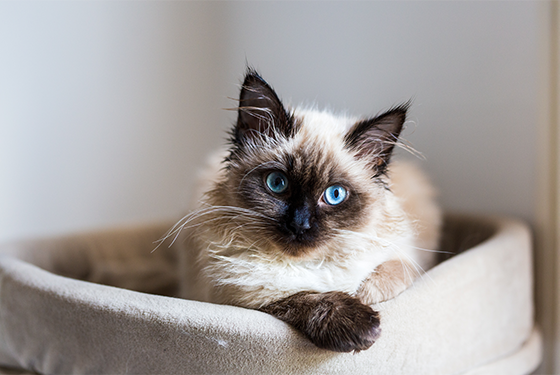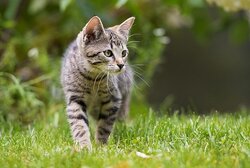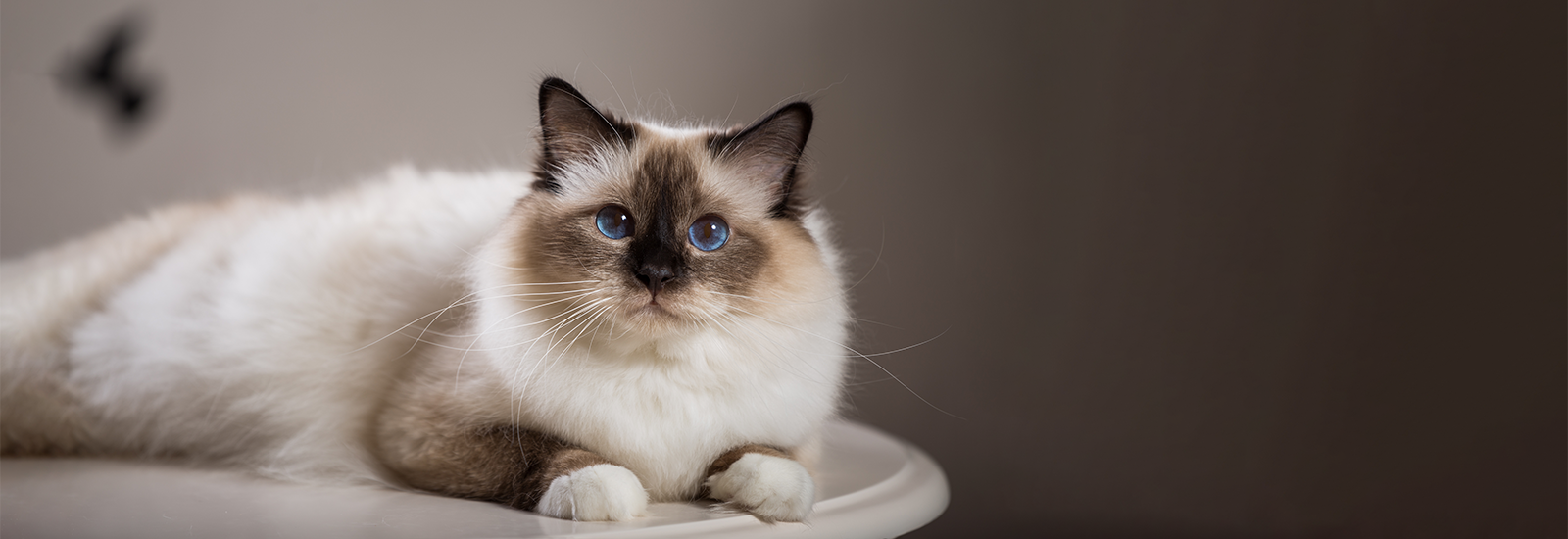Birman
The Birman is not only in its appearance a perfect mixture of a Persian and a Siamese cat. Its character also combines the best of both breeds.
Profile of the Birman
- Size medium
- Weight female: approx. 3.5 kg, male: approx. 5 kg
- Origin France
- Build slightly elongated, female is more petite
- Length of fur medium-long
- Colour of fur light with “points”
- Grooming minimal
- Behaviour talkative, social
- Character gentle, calm
Appearance and character of the Birman
The Birman is a medium-sized breed of cat, the male of which should be significantly larger than the female. They have a slightly elongated body and relatively short, sturdy legs. Their ears are fairly small with rounded tips. Their deep blue eyes are always particularly beautiful. Regarding its body shape and coat, the origins of the Birman are obvious: it has the coat pattern of a Siamese and the physique and fluffiness of a Persian cat. The coat is medium-long to long, silky in texture and with very little undercoat. Particularly striking are the white “mittens” on all paws. These should preferably have the same appearance on all four legs. The colour of the coat itself is, however, different: its basic colour is subdued white with “points”. These are the darkened areas on the face, ears, legs and tail. They become increasingly darker during the first few months of the cat’s life. Originally, the colour of the Birman was always blue or seal, but they can now also be found in chocolate, red, purple and cream.
What applies to their character is also true when it comes to their appearance:
The Birman is a successful mixture of a Persian and a Siamese cat. It has the gentle and calm nature of the Persian cat and the talkativeness and close relationship to humans of the Siamese. This makes them a very pleasant and unobtrusive breed of cat. They are easy to integrate into the family and adore contact with their humans. They always enjoy an exciting game of cat-and-mouse, but afterwards they will also be glad to find a quiet spot on the cat tree to get away from all the hustle and bustle.

Keeping and caring for a Birman cat
Having a Birman as a pet is normally not at all problematic. It is not particularly demanding, nor is it noisy, overly independent or tiring to have in your household. It adapts very well to everyday life, but does require plenty of love and attention. If you are unable to provide this, it would be better to have two cats. This will only involve minimal additional effort, and the cats will be much happier. Making sure that they have plenty of variety in their home with a cat tree, a cosy bed and lots of toys will also help immensely. Your pets will then have no problem with not being allowed outside. The cats will not only have each other, but their humans will also be there for cuddles or an exciting game with their cat fishing rod.
In terms of grooming, the Birman also occupies a perfect position between the Siamese and the Persian cat. It is neither a short-haired cat with minimal grooming requirements, nor does it involve the increased time and effort needed for a Persian cat. This is primarily due to the fact that it has hardly any undercoat. Its fur is therefore only very rarely prone to matting. Birmans should nevertheless be combed regularly. This is especially important during the moulting process. This will not only reduce your housework, but your pet will also swallow less fur when it licks itself.
Nutrition
Whether it’s a kitten, an adult cat or a senior – the food for a Birman cat should always be of high quality and tailored to its age. Cats are carnivores by nature, so cat food should always contain a high proportion of meaty ingredients. Sugar, flavour enhancers and artificial colourings and preservatives do not belong in the food.
animonda has the ideal food for every stage of your cat’s life. You can choose between kitten, adult and senior cat food. The products are specially formulated to meet the specific nutritional requirements of the different life stages of cats. This provides the best foundation for your pet to enjoy a long and healthy life.
Health of the Birman
The Birman is considered to be a healthy and robust breed of cat. Hereditary diseases cannot, however, be ruled out. Responsible breeders will therefore have all their cats genetically tested and will exclude any cats with health issues from breeding. For this reason, if you are interested in a Birman cat, make sure that you find a reputable breeder who is able to document their commitment with health certificates.
Despite preventive health care, illnesses can occur. These include polycystic kidney disease (PKD), where cysts form on the kidneys. Although there is no cure for this condition, it can be treated and delayed by means of medication.
Another hereditary condition that occasionally affects the Birman is the neurological disorder “hypomyelination”. This results in a developmental impairment of myelin, which is used for communication between the cells in the nervous system. The result is uncoordinated movements and muscle spasms and twitches. These occur in phases and should be assessed immediately by a vet.
History and breeding
There is a legend that Birman cats used to live in the temples of Burma. In reality, however, they were probably never seen there. Their origins lie in France. This is where in around 1920 a Persian female cat and a Siamese male cat were inadvertently – or perhaps intentionally – paired. The people were so enamoured with the result that specific breeding began immediately. It only took until 1925 for the Birman to be recognised as a breed in France. A few years later, breeding started in Germany, however this was greatly hampered by the turmoil of the Second World War and did not improve again until 1955. The breed had already been recognised by the European governing body, FIFé, in 1949.
Even though hardly anything has changed regarding the point markings, more and more colours have appeared over time. These are mainly thanks to English breeders. Today, the Birman can be found in the colours seal, blue, chocolate, purple, red and cream. The breed standard also includes the tortie and tabby variations.
You may also like this

Feeding kitten - nutrition tips
What kittens need for healthy development

Good cat food
How to recognize good cat food for your darling

A kitten is moving in
Tips for collection, initial equipement and settling in

Getting your cat used to being outdoors
How to get your cat used to going outside

